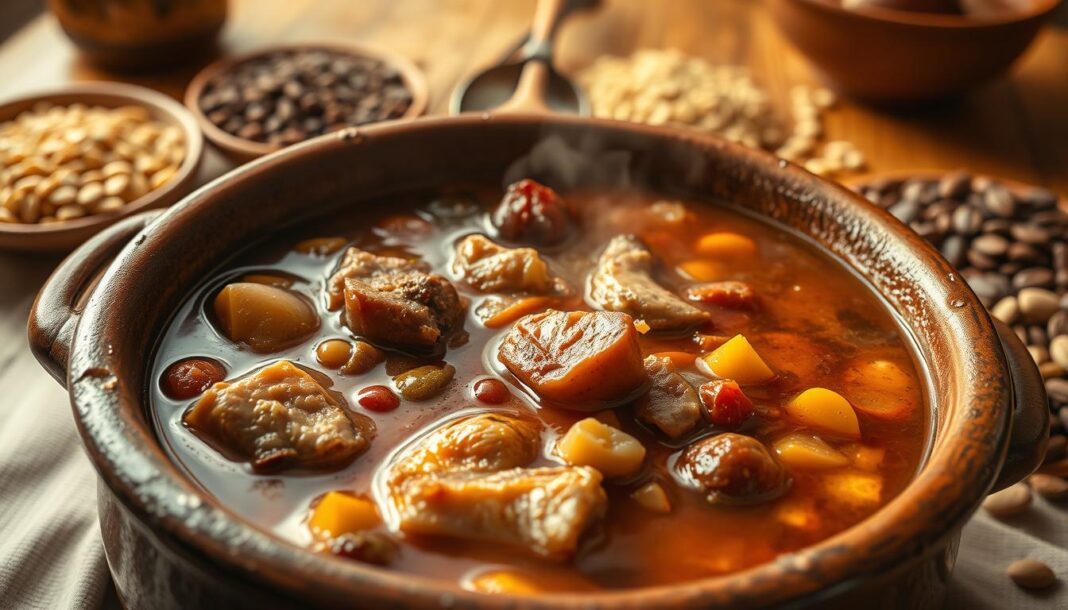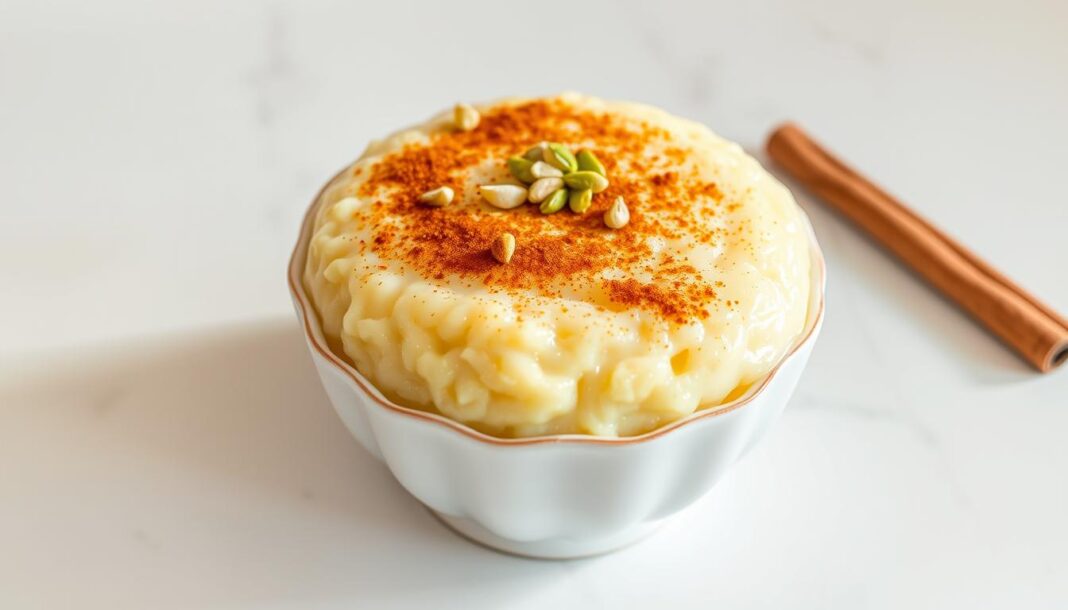We explore the rich history and multifaceted significance of a traditional Spanish stew that has become a cultural touchstone. Olla podrida, literally translated as “rotten pot,” is a hearty dish made with a variety of meats, legumes, and vegetables slow-cooked to perfection. This culinary masterpiece has not only been a staple in Spanish cuisine but has also transcended its gastronomic origins to become a metaphor for a mixture of diverse elements.
The term “olla podrida” is believed to be derived from “poderida” or “powerful pot,” signifying its rich flavor profile and cultural importance. As we delve into the etymology and evolution of this dish, we uncover its significance in Spanish society, where the abundance of ingredients in the stew signified wealth and status.
Key Takeaways
- Understanding the dual meaning of olla podrida as both a Spanish dish and a metaphor.
- Exploring the etymology and historical context of the term.
- Examining the cultural significance of olla podrida in Spanish cuisine.
- Analyzing its use as a linguistic metaphor in literature and everyday speech.
- Discussing the socioeconomic dynamics represented by the dish.
What Is Olla Podrida?
Olla podrida, a term with Spanish origins, has multiple meanings that are worth exploring. At its core, it refers to a traditional Spanish and Latin American stew.
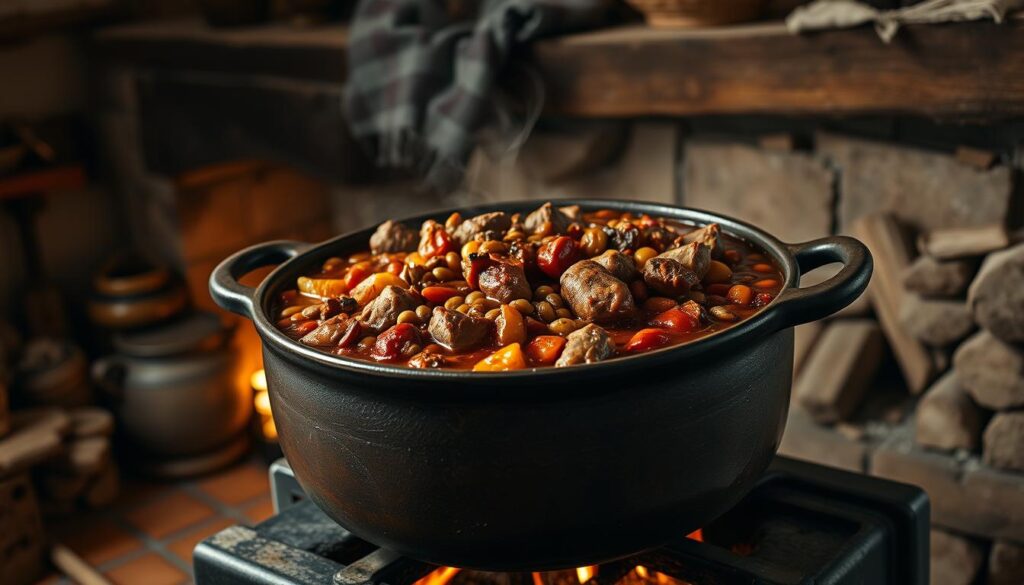
Dual Definitions
Olla podrida has two primary definitions. Firstly, it is a rich, highly seasoned stew made with various meats and vegetables, typically including sausage and chickpeas, slowly simmered to create a flavorful dish. Secondly, it is used metaphorically to describe a hodgepodge or a miscellaneous collection of items. This dual meaning is reflective of the dish’s nature—a mixture of diverse elements coming together.
Etymology and Literal Translation
The term “olla podrida” is derived from Spanish, where “olla” means pot or cooking vessel, and “podrida” translates to rotten. However, the name is somewhat misleading, as the dish is not rotten but rather a rich combination of ingredients. The word “podrida” likely evolved from “poderida,” meaning powerful. For more detailed information on the term, you can visit Wiktionary’s definition of olla podrida.
The Historical Origins of Olla Podrida
Tracing back to medieval Spain, olla podrida was a fundamental part of the culinary landscape. It evolved from a simple peasant dish to a celebrated culinary tradition enjoyed across various social classes.
Spanish Culinary Roots
Olla podrida originated as a hearty stew made with available ingredients, including various meats and vegetables, cooked in a large pot. This dish was reflective of the historical circumstances of its time, utilizing cooking methods and ingredients typical of pre-industrial Spain. As it gained popularity, olla podrida became a staple in Spanish cuisine, with different regions adapting the recipe to their local ingredients and preferences, resulting in various versions of the dish.
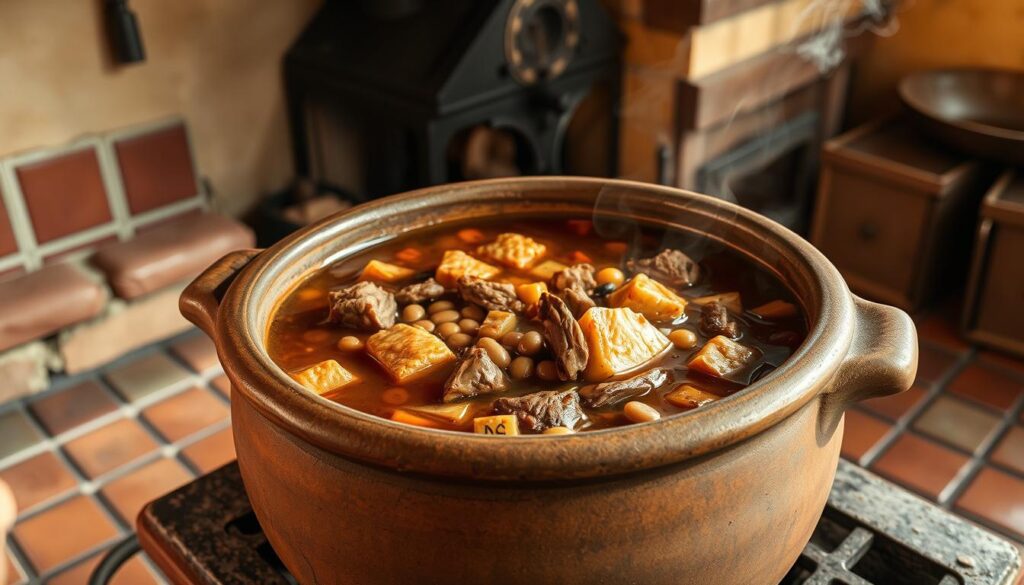
| Period | Culinary Characteristics | Social Significance |
|---|---|---|
| Medieval Spain | Simple, hearty stew made with locally sourced ingredients | Peasant food, basic sustenance |
| 17th Century | Evolution into a more complex dish with diverse ingredients | Gained popularity across social classes, referenced in literary works |
Literary References Through History
By the 17th century, olla podrida had gained fame beyond Spain’s borders, being referenced by notable figures such as Samuel Pepys and Robert Burns in their literary words. The dish was mentioned in Cervantes’ “Don Quixote,” where Sancho Panza identifies a bubbling pot as an olla podrida, further cementing its place in cultural consciousness. These literary references not only highlighted the dish’s popularity but also transformed it into a cultural symbol, representing diversity and abundance in various contexts beyond its culinary origins.
Understanding Olla Podrida Meaning in Culinary Context
The name “olla podrida” may translate to “rotten pot,” but its culinary importance is undeniable. To grasp its significance, we need to explore its historical and cultural context.
The “Powerful Pot” Interpretation
The term “podrida” in “olla podrida” is likely a corruption of “poderida,” meaning “powerful.” This interpretation reflects the dish’s substantial nature and the wealth required to prepare it, as it was made with various meats and vegetables. The use of numerous ingredients signified prosperity and status.
Social and Economic Significance
Olla podrida was a display of hospitality and generosity, showcasing the host’s means through the variety and quality of ingredients. The preparation of this stew created a clear difference between wealthy households, who could afford numerous types of meat, and poorer families, who might make simpler versions. The dish embodied concepts of power, wealth, and social standing.
| Aspect | Description | Significance |
|---|---|---|
| Ingredients | Various meats and vegetables in one pot | Reflected wealth and status |
| Culinary Practice | Preparation of stew with multiple ingredients | Showcased hospitality and generosity |
| Social Impact | Highlighted the difference between social classes | Embodied concepts of power and wealth |
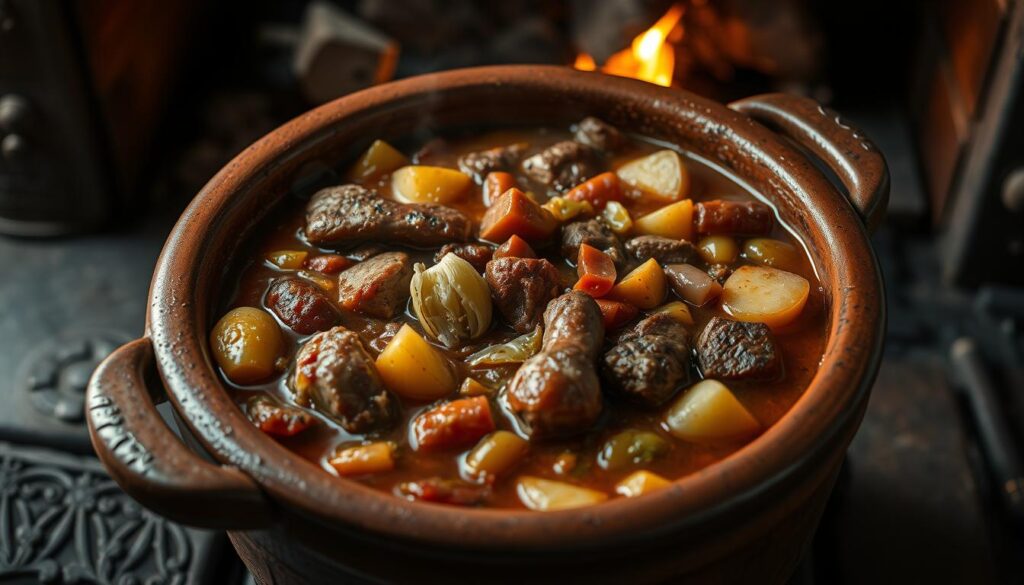
Traditional Ingredients and Preparation
At the heart of Spanish cuisine lies olla podrida, a stew renowned for its complex flavors and assortment of ingredients. This traditional dish is characterized by its rich composition, typically featuring a combination of legumes, various meats, and an array of vegetables.
Essential Components
The foundation of olla podrida is built upon chickpeas or beans, which are then complemented by an assortment of meats including pork, beef, bacon, partridge, chicken, ham, and sausage. The inclusion of various vegetables such as carrots, leeks, cabbage, potatoes, and onions adds depth and complexity to the stew.
Cooking Methods
The traditional cooking method for olla podrida involves a slow simmering process that allows the diverse flavors to meld together over several hours in a heavy pot. This patient approach to cooking is crucial for developing the rich, harmonious flavor profile that characterizes this dish.
The Relleno Addition
A unique aspect of traditional olla podrida is the inclusion of relleno, small egg dumplings made from beaten eggs mixed with breadcrumbs and seasoned with garlic and parsley. Although less common in modern versions, these dumplings historically added an extra layer of complexity to the dish.
The preparation of olla podrida exemplifies culinary wisdom, with each ingredient added at specific times to ensure proper texture and flavor development. The combination of various elements in this one-pot meal creates a harmonious whole that is greater than the sum of its parts, reflecting the metaphorical significance of olla podrida.
Regional Variations Across Spain and Latin America
Olla podrida’s rich history is reflected in its diverse regional interpretations across Spain and Latin America. This hearty stew has evolved differently in various regions, influenced by local ingredients and cultural traditions.
Burgos Style vs. Other Spanish Versions
The city of Burgos is particularly famous for its version of olla podrida, which traditionally uses local red beans. In contrast, other Spanish regions predominantly use chickpeas, a staple in the Spanish diet well into the 20th century. This difference highlights the regional adaptability of the dish.
Colonial Adaptations
As Spain colonized the New World, olla podrida spread and evolved, incorporating local meat and vegetables. This resulted in distinctive versions of the dish across Latin America, such as in Mexico. Each version maintained the essence of the original pot dish while adapting to new ingredients and cooking traditions.
- The Burgos style uses local red beans.
- Other Spanish versions primarily use chickpeas.
- Latin American adaptations incorporate local ingredients.
By examining these regional variations, we can appreciate the flexibility and resilience of olla podrida as a culinary tradition. The list of differences between these versions provides a fascinating glimpse into the cultural exchange and adaptation that has shaped this beloved stew over words of mouth and across century.
Olla Podrida as a Metaphor
The term olla podrida has transcended its origins in Spanish cuisine to become a versatile metaphor used across various contexts. This evolution is a testament to the dish’s cultural significance and its ability to evoke vivid imagery of diverse elements combined in a single entity.
Linguistic Evolution
The linguistic journey of olla podrida into other languages, including English, demonstrates its adaptability and widespread use. It has been employed in literature and everyday speech across different centuries, reflecting changing understandings of both its literal and figurative definitions.
Similar Terms and Synonyms
Olla podrida is associated with a plethora of synonyms that convey the idea of mixture or diversity. Terms like medley, hodgepodge, potpourri, and mishmash are often used interchangeably, though subtle differences exist between them. For instance, while medley typically refers to a mixture of different things, often in a musical context, hodgepodge implies a more random or confused mixture.
A comprehensive list of similar terms includes: assortment, variety, collage, jumble, alphabet soup, crazy quilt, macédoine, patchwork quilt, omnium-gatherum, montage, clutter, jambalaya, jungle, salmagundi, farrago, blend, grab bag, litter, shuffle, salad, hash, scramble, miscellanea, pastiche, patchwork, amalgam, mélange, gumbo, rummage, combination, tangle, mixed bag, mishmash, ragout, smorgasbord, agglomeration, agglomerate, gallimaufry, miscellany, stew, ragbag, botch, accumulation, olio, menagerie, hotchpotch, tumble, motley, odds and ends, welter, aggregate, muddle, notions, alloy, fusion, aggregation, composite, sundries, conglomerate, mess, compound, conglomeration, detritus, catchall, intermixture, admixture, chaos, dog’s breakfast, commixture, oddments, disarray, disorder, mix-up, imbroglio, confusion, disarrangement, shambles, morass, snarl, knot.
Conclusion
In conclusion, olla podrida enriches our understanding of both culinary and linguistic heritage through its dual identity as a beloved Spanish stew and a metaphor for mixture. This single culinary entry in food history represents a fascinating intersection of gastronomy, linguistics, and cultural exchange. The combination of various meats, vegetables, and legumes in the pot symbolizes cultural blending over time.
As we search for authentic culinary experiences, we discover rich historical narratives embedded in traditional recipes like olla podrida, which often feature beef as a key ingredient. Understanding the meaning behind such dishes enhances our appreciation of culinary heritage. While not directly related to music, the harmony of flavors in olla podrida can be seen as a culinary symphony.
